

Machiavelli of Greece
Small map, Continents, 5 AI Opponents
Deity difficulty
Patch 1.2
I was starting to get a bit tired of Civ7's gameplay by this point some three months after the initial release. While the early stages of the gameplay during the Ancient era continued to be genuinely engaging, everything associated with the era transitions and the legacy scoring goals felt more and more repetitive. It's bad enough that Civ7 is asking the player to complete the same goals in every single game, but even worse is the way that it rips away control on two separate occasions with the forced era switches. I truly detest how Civ7 suddenly decides that the era is finishing with little warning ahead of time, then proceeds to tear down all of my cities, obsolete nearly all of my buildings, and teleport my units to random spots on the map (when not outright deleting many of those units!) I was disappointed by my Himiko game on Deity as dialing up the difficulty to its maximum setting did nothing to solve these problems. I've been able to play literally hundreds of new starts in games like Civ4, Master of Orion, and FTL over the years without getting bored, whereas I found myself getting tired after barely half a dozen games of Civ7. Not a good sign.
I felt that I needed to try something completely new and different if I wanted to remain engaged with Civ7. Since the AI leaders didn't put up much resistance in my last Deity game, I decided to test out a truly radical variant that had been bubbling around in my head for some time: no buildings. In other words, the player would have to rely solely on the rural tile improvements and any wonders that might be completed to find some kind of path to victory. It was a completely insane idea that shouldn't have any chance of success, going through the whole game without ever placing a single urban building, however I'd been thinking about this for a while and thought that I could see a way to pull it off. I'd have to choose the settings for this game very carefully, starting with the leader choice:
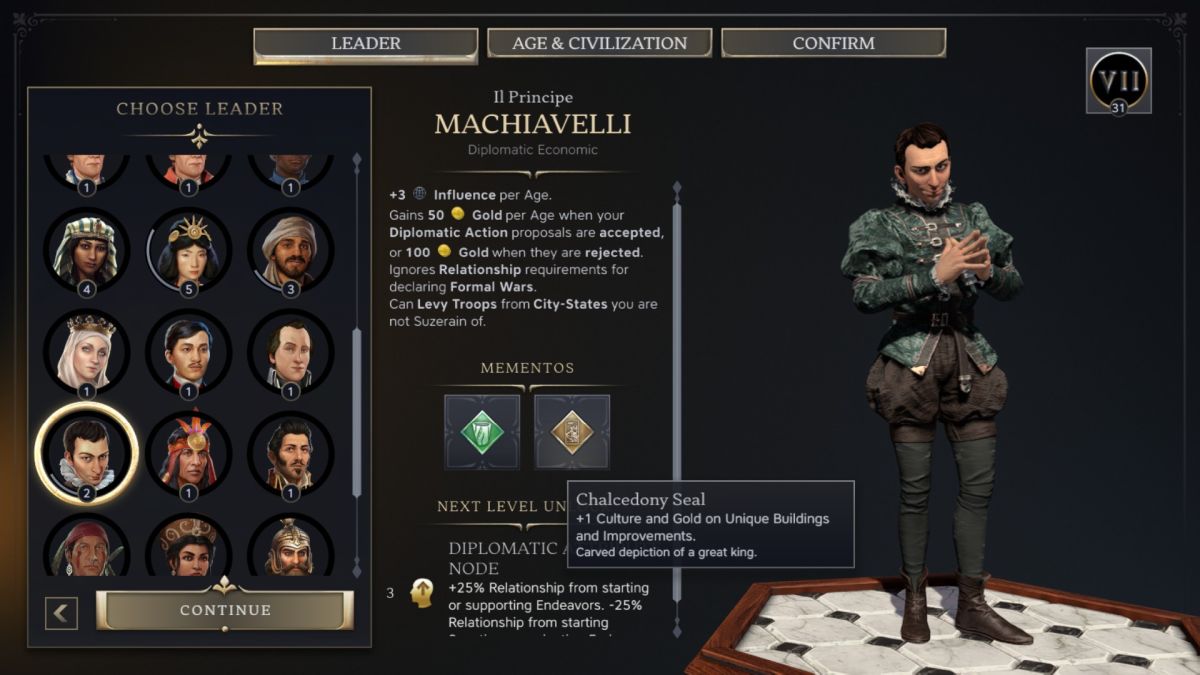
My pick would be Machiavelli for this crazy idea, a leader who I hadn't used yet. Machiavelli has a whole bunch of diplomacy-related abilities, as you'd expect given his historical background (though Firaxis seems to be using the caricatured version of Machiavelli from popular culture and not his actual beliefs on statecraft). This leader gets 3 influence per age as a basic ability, which is much better than it sounds and particularly powerful in the Ancient era. He also gets a bunch of gold from other leaders accepting or rejecting his diplomatic proposals, he can ignore the requirements for declaring a Formal War, and he can levy units from city states without having to suzerain them ahead of time. Again, everything here was related to diplomacy in some way which might seem like an odd fit for the variant that I'd be running - I'll explain shortly why Machiavelli's influence generation was a necessity to make this work.
I also had to tailor my two memento choices to fit this setup. Neither of the ones that I wanted were unlocked yet and I certainly wasn't playing three or four full games to completion just to unlock the Level 9 memento of Xerxes. So I downloaded one of the basic mods that unlocks all of the mementos, not particularly caring to engage in the XP farming nonsense that has been added into this version of the series. My choices were Poteskwate from Tecumseh: +1 food per age in settlements for each city-state you control and the pictured Chalcedony Seal from Xerxes: +1 culture and +1 gold on unique buildings and improvements. I knew that I was going to rely on city states and their unique tile improvements which would synergize perfectly with these mementos. My goal was to find as many of the independent powers as possible, befriend them, and then reap the benefits of these mementos.
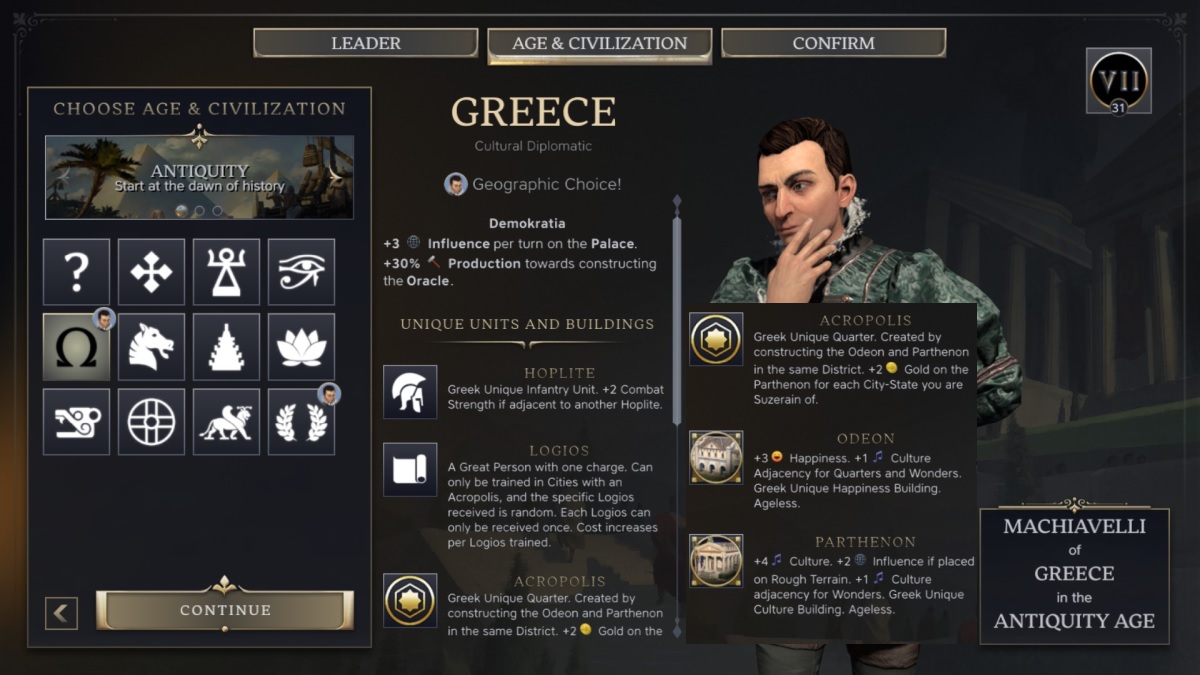
For the civ choice, there was really no alternative other than picking Greece. Again, this might have seemed like an odd selection at first since most of the Greek unique items were associated with the unique Acropolis quarter which I wouldn't be able to construct under this variant. And if I couldn't build any Acropolises, then I couldn't train any of the Logios Great People either, not that Great People are very useful anyway in Civ7. What Greece did have was another bonus to influence generation: 3 additional influence per turn on the palace which would allow me to start the game making 16 influence/turn instead of the default 10 influence/turn. Furthermore, the Greek unique civics tree also had a policy which would make things enormously easier in terms of befriending city states, and as a "tradition" it would stick around for the future eras as well. I could use the Greeks for the Ancient era and then swap to other civs that better fit this variant when transitioning into the later ages.
A small note here: I actually played out the whole Ancient era with Machiavelli/Greece in a separate game before running the game described below. It went quite well overall but I had selected the "long duration" era option to see what it would look like. That proved to be a mistake as I reached the maximum limit of allowable expansion by Turn 100 and then was stuck, unable to place further settlements due to Civ7's stupid city limit. Meanwhile, the Ancient era kept dragging on and on and on, allowing the AI civs to keep growing and expanding as it dragged out past Turn 150. This was clearly bad for the variant that I was playing as it was not in my interest to give them longer amounts of time to keep scaling upwards. I decided that I had to start over again with the normal age duration in place, plus I added the mod that unlocked all of the mementos and swapped over to the pair described above which better fit this setup. I did learn a number of lessons about how to better run this variant which I'll describe over the course of this report.
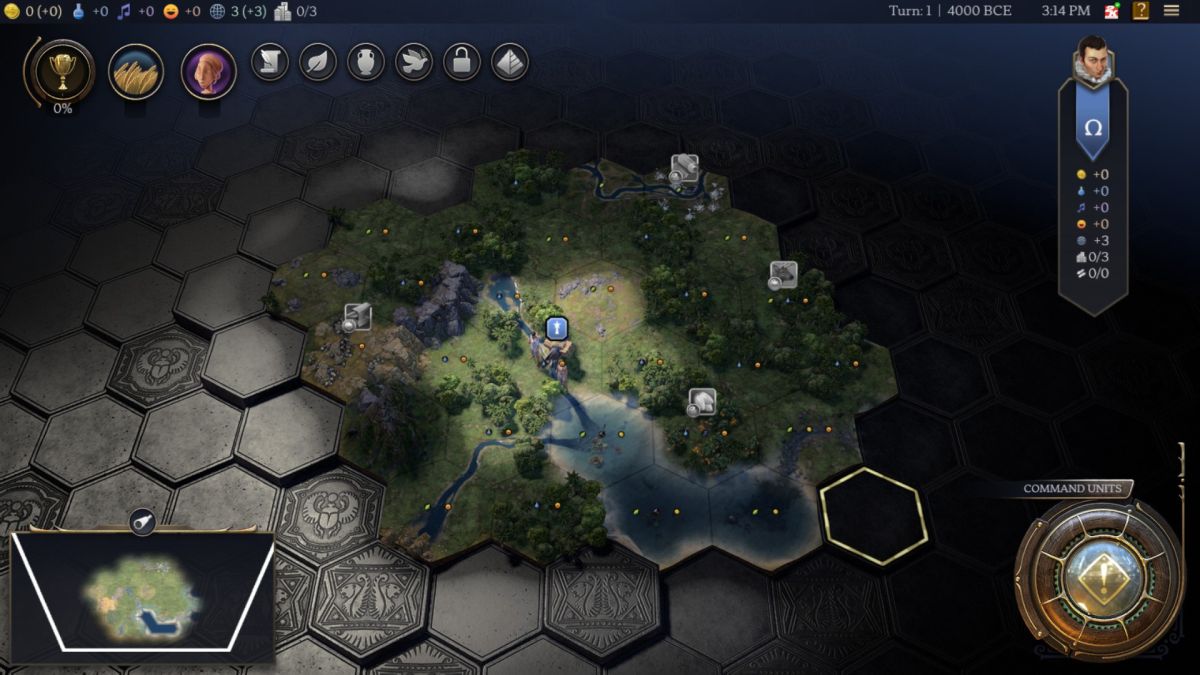
I rerolled a couple of starts that only had empire-wide resources present before finding this location that I liked. While there weren't any resources here that boosted production, the deer and mango resources both added to food which would be almost as good given the need to reach size 5 quickly. Remember, cities can't start producing settlers in Civ7 until they hit the magic size 5 mark and I wouldn't be able to rush out a granary or saw mill to add +1 size from an urban district. I moved a tile to the east to get those food resources closer, which prompted the discovery of a sugar resource hiding over there in the fog, very nice. That was another food-boosting resource and moving the iron tile out to the third ring wasn't a big deal since iron can't be assigned to an individual city. I began by training a scout and would wind up building four scouts in total while waiting for city growth to take place.
The initial city growth was onto the mango tile which had an effective yield of 2 food / 1 beaker / 3 culture / 1 happiness after assigning the resource to my capital. The following turns saw my scouts begin defogging the map while attempting to grab as many of the goodie huts as possible. There were more of them to be found than normal because I had swapped the map over to "Balanced" for this game, a setting that spaces out the player and the AI civs at equal distances from one another. The default setting deliberately crams several AI civs right on top of the player's starting position which is a true asshole move from the game developers that the vast majority of players won't even realize is happening to them. There was notably more open space available on this map now that I was playing under fair settings as opposed to the Civilization equivalent of a rigged carney game.
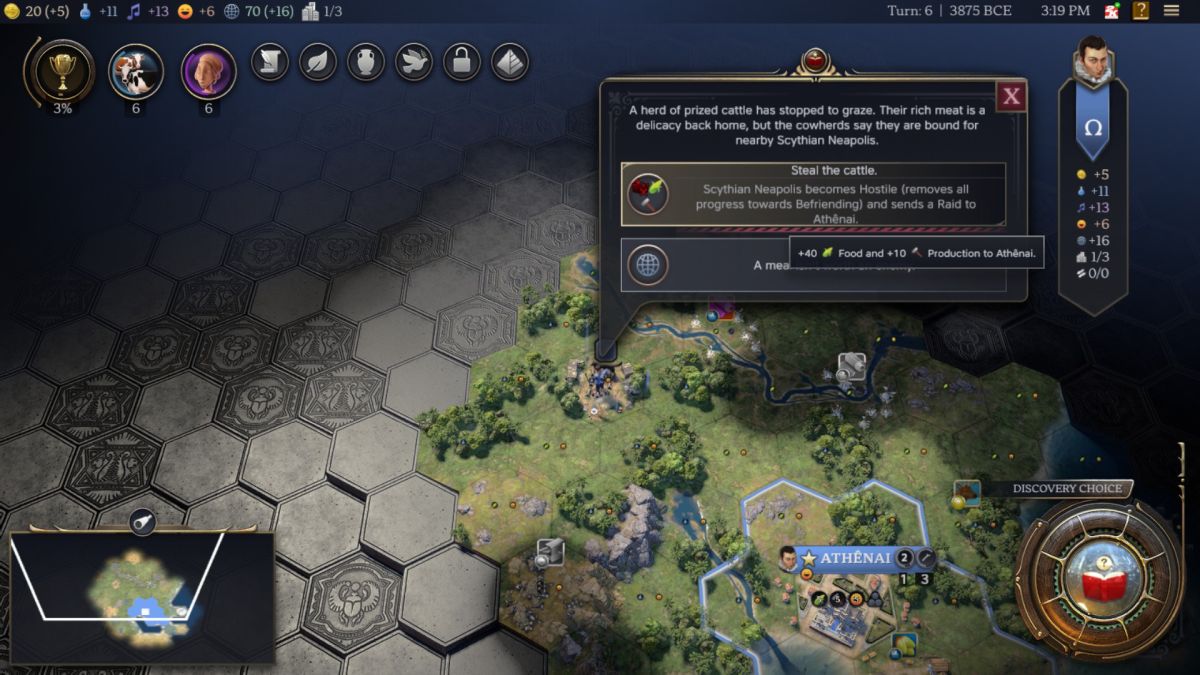
I landed two big bonuses from the goody huts during these initial turns. The first one gave 40 food and 10 production to my capital in exchange for the nearest independent power going hostile. This was a no-brainer choice to make since 40 food was worth almost an entire city growth on its own while 10 production knocked out a third of the cost of a scout. This event was also supposed to cause the independent power to send a "raid" in my direction but I never saw anything of the sort from them. The other hut granted me a free hoplite unit for the tradeoff of losing out on a single turn's worth of gold income. Well, I was making all of 5 gold/turn at the moment and trading a whole 5 gold for an entire free unit on Turn 9 was a fantastically good deal. Sign me up! That hoplite did some additional exploration near the capital and was ready to protect me from the tribal raid that never took place.
A few turns later I met my first AI competitor in the form of Catherine:
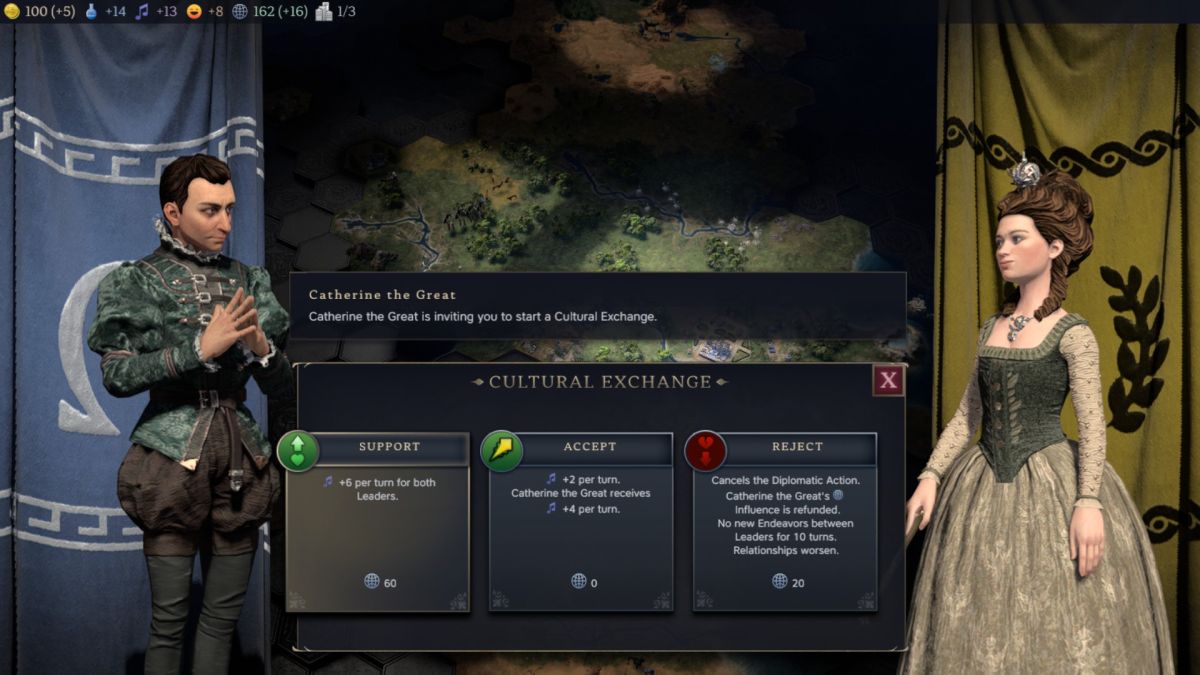
I spent 20 influence on the initial friendly greeting, then she came back on the next turn asking for this cultural exchange. While I had the influence to support her proposal, I had to think about whether to spend the full cost of 60 as opposed to saving for an independent power friendship. Ultimately I decided that this would be worthwhile, as gaining 6 culture/turn in the early game is extremely valuable and would speed me along to the first Greek civic that I wanted to research. It would also help build good relations with Catherine since supporting endeavors is one of the biggest positive factors in Civ7's diplomatic system. Himiko could have done this for free but of course she wouldn't have been getting the extra influence that I had here with the Machiavelli/Greece combo.
It wasn't long before I ran into the other two AI leaders on this continent; remember, every Small map in Civ7 will always have exactly three AI opponents on the starting continent unless the player starts mass removing the AIs on the settings screen. These turned out to be Frederick and Amina who had rather annoying leader agendas to deal with. Frederick dislikes whoever has the smallest military (guess who that will be on Deity?) while Amina dislikes civs that settle on plains and desert tiles. Her agenda is utterly bizarre and feels absurdly "gamey" for lack of a better word; who in the real world would ever care about something like that? Catherine's leader agenda by contrast fit well with my variant, as she likes civs with few Great Works and dislikes those who have lots of Great Works. Normally that's a case of practically hardwiring Catherine to hate the player as they collect codexes and relics, however in this game I would never have libraries or temples to slot the great works. I hoped that this meant we could become eventual friends.
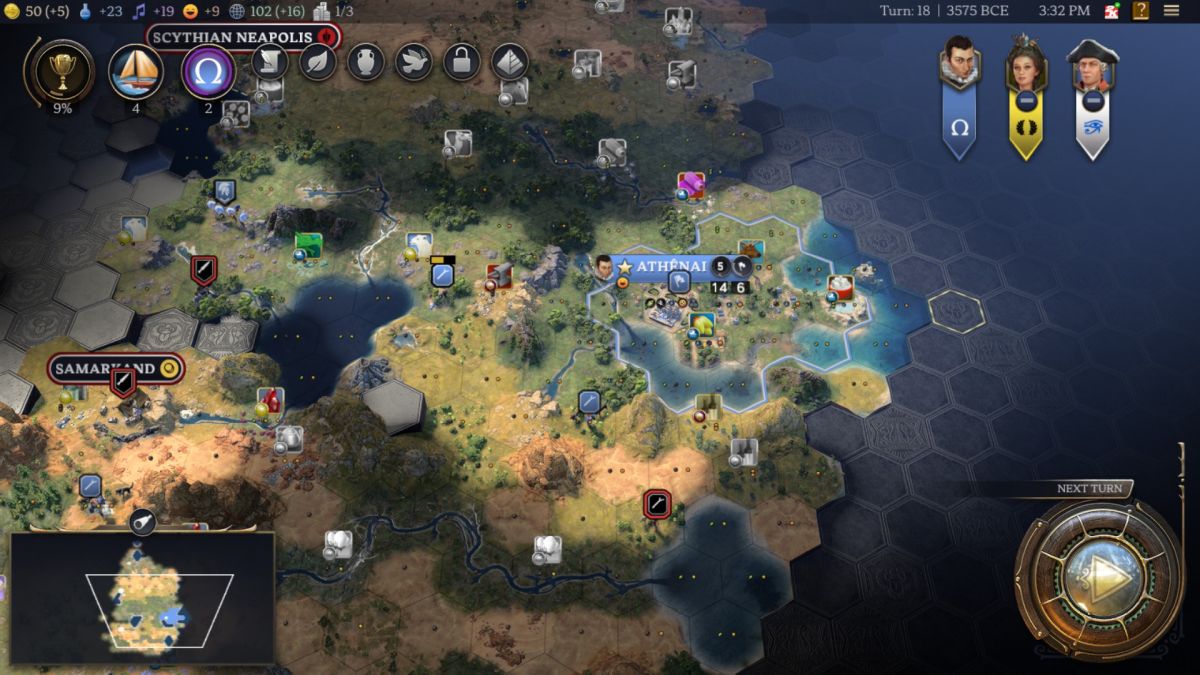
This was the overview by Turn 18 which was notable for being the turn that my capital reached the magic size 5. Now that the capital could start training settlers, that was exactly what I was doing. In fact, I cash-rushed a settler with the gold that had been accumulating from various goody huts while hand-building a second one. I even had several turns of production already invested into that second settler thanks to Shift-Enter abuse of an empty production queue over the previous turns. Elsewhere at the capital, I had the deer and mango resources connected and slotted into Athenai with a plan to pick up the sugars next. The city's yields were pretty sad as a result of not being able to construct any of the warehouse buildings to boost rural tile yields but Athenai was doing about as well as it could given the crazy variant under which it was operating.
I selected one of the Greek unique civics to research as soon as the default Chiefdom civic was out of the way. This was something known as Ekklesia which cost 150 culture and unlocked half of the Greek unique Acropolis district. That's the main reason why players would want this civic in a normal game, however it also held one of the Greek traditions which would be super useful for this variant:
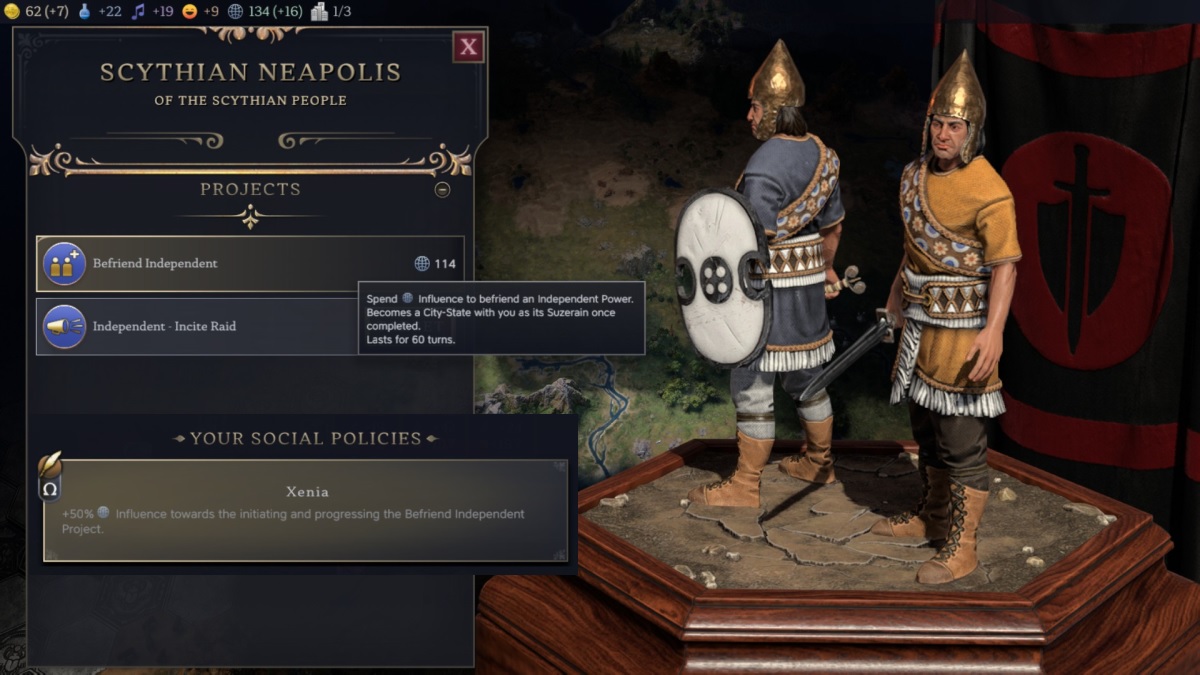
This was Xenia: +50% influence towards towards the initiating and progressing the Befriend Independent Project. The math on this is a little weird because it doesn't cut the cost of befriending an independent power in half, it adds +50% towards the influence that the player is spending to carry out the friendship project. In other words, the default cost to befriend independent powers in the Ancient era is 170 influence. Xenia doesn't reduce this by half down to 85 influence, it instead grants 1.5 influence per 1 influence spent and therefore drops the cost of the project down to the pictured 114 influence. Even with that caveat, this was still super useful and a core component of my strategy for this variant. Now I could make friends with the various IPs at a much cheaper rate, barely over 7 turns worth of influence accumulation at my current 16/turn income. Compare that to the normal requirement of needing 17 turns at 10 influence/turn to sum up the usual 170 influence to start the friendship process - this was much, much faster.
This was the other reason why Greece was such an important choice for this game, both providing an extra 3 influence/turn on the palace and then also bringing this unique policy to the table. Like I said earlier, as a tradition it would also remain an option for the following eras and hopefully allow me to snap up every IP immediately once they respawned. This was also the reason why I could support that cultural exchange endeavor with Catherine earlier: by getting to Xenia faster, it literally paid for itself! That exchange had cost 60 influence but then I saved 56 influence on the very first friendship project as pictured here. Now I only had to wait out the 30 turn timer for the friendship process to complete (with Scythian Neapolis unfortunately being hostile due to that early event) and I'd have my first city state ally.
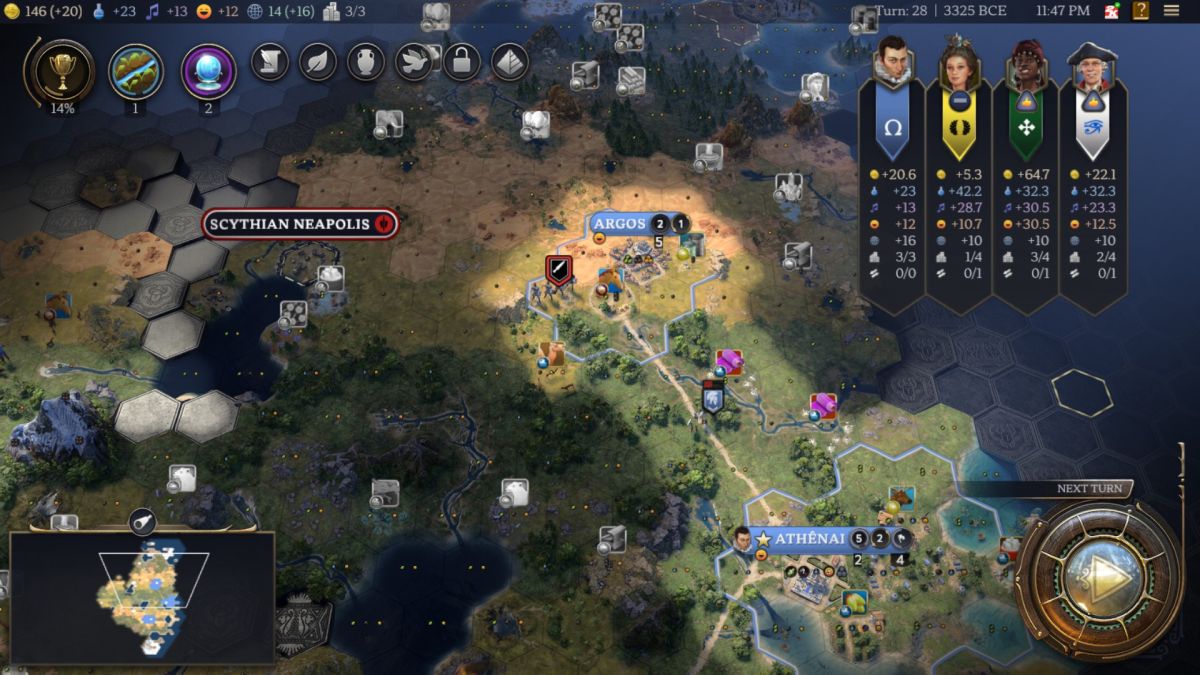
Those first two settlers both established new settlements on the map during the following turns. First I founded Mykene to the southwest of the capital on Turn 25 in a beautiful desert floodplains region with a pair of nearby cotton resources to help it get off and running. The pictured Argos follwed three turns later in a more rugged part of the map that had good long term potential with a series of rough tiles that could become eventual mines. Athenai was working on another settler to establish settlement #4 for lack of anything better to build, with Irrigation research about to complete and raise the settlement cap by another point. I had no militay beyond that one hoplite popped from a goody hut and that looked like it was going to cause a problem over at Argos where a single hostile sword had appeared. It would be joined by a slinger as well which forced me to cash-rush a hoplite for defense there; I guess I pushed the farmer's gambit a little too hard, whoops.
The comparative ribbons in the corner of the screen showed that I was trailing behind the AI civs, no surprise given that this was Deity difficulty and I lacked any buildings. Amina and Frederick seemed to be doing reasonably well but Catherine was struggling for no clear reason. Why did she still only have a single settlement almost 30 turns into the game with all of the Deity bonuses? How could she possibly be making only 5 gold/turn in income? That was the least of her insanity as she chose to denounce me right around this point in time - what the heck?! The denouncement mechanism costs influence and proceeds to drop the relationship between the two players in question by 60 points unless the other party pays more influence to block the denouncement. I didn't have 120 influence to stop Cathy's denouncement and I wouldn't have paid it even if I did since I needed that influence for befriending independent powers. I thought that this was insanely stupid on Cathy's part, only for her to denounce me a SECOND TIME half a dozen turns later!!!  She had set hundreds of precious early game influence on fire for absolutely no reason other than poisoning the well with a peaceful trading partner. She could have used that influence on exchanges to boost her science and culture, but no, instead she used it to practically guarantee war with my civ which had never made any hostile gestures and with which she had no border tension whatsoever. What a freaking moron.
She had set hundreds of precious early game influence on fire for absolutely no reason other than poisoning the well with a peaceful trading partner. She could have used that influence on exchanges to boost her science and culture, but no, instead she used it to practically guarantee war with my civ which had never made any hostile gestures and with which she had no border tension whatsoever. What a freaking moron.

The next dozen turns passed by quietly even as diplomatic relations from Cathy's double denouncements ticked down in the background. The pair of them dropped relations very quickly, followed by the inevitable war declaration shortly thereafter on Turn 44. Now this was Deity difficulty where the AI civs get huge production bonuses and a truly massive +8 combat strength in every battle. I should have been shaking in my boots at the prospect of a war this early on with Catherine. Instead, she launched this war and followed it up by sending... exactly one warrior against Mykene. I brought another hoplite down here and the pair of them were more than sufficient to defeat this solitary enemy, even with the big strength bonus that Cathy was receiving. And that was it, she never sent any following units for dozens of turns afterwards. Just the one warrior and that was it.
It's difficult to avoid the conclusion that the Civ7 AI is a drooling idiot when it engages in behavior like this.  Catherine's double denouncements made no sense whatsoever, with the image above demonstrating how far apart our civs were located. What was the urgent incentive to denounce someone this far away with tons of open land to be claimed? Then she declared war, sent a single unit to attack, and never bothered to do anything with the rest of her military. So while the Civ7 AI does a solid job of defending itself by spamming out units when it gets attacked, it appears to be practically hopeless when the shoe is on the other foot and it needs to launch its own invasion. I had a low opinion of the AI's performance going into this game and somehow Catherine managed to disappoint even my miniscule expectations.
Catherine's double denouncements made no sense whatsoever, with the image above demonstrating how far apart our civs were located. What was the urgent incentive to denounce someone this far away with tons of open land to be claimed? Then she declared war, sent a single unit to attack, and never bothered to do anything with the rest of her military. So while the Civ7 AI does a solid job of defending itself by spamming out units when it gets attacked, it appears to be practically hopeless when the shoe is on the other foot and it needs to launch its own invasion. I had a low opinion of the AI's performance going into this game and somehow Catherine managed to disappoint even my miniscule expectations.
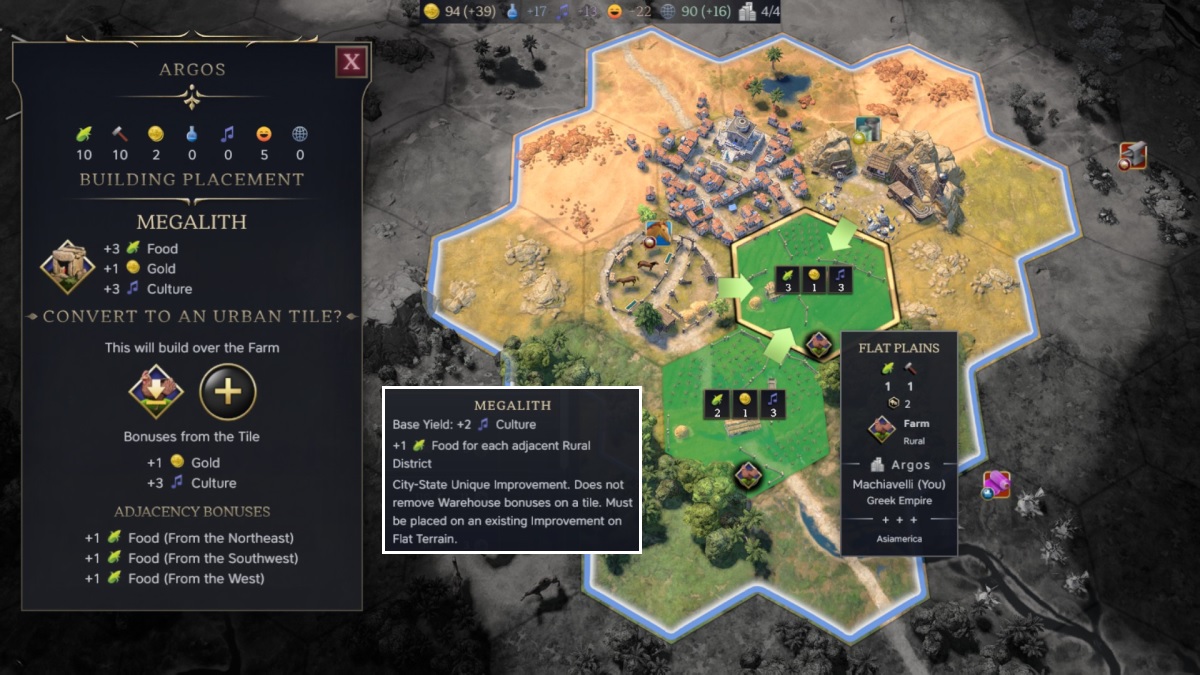
More significantly, at the same time that Catherine was starting this foolish conflict, I had also ticked up to full city state alliance status with an independent power in the northeast corner of the map. This was a Cultural IP which allowed me to pick the most important friendship benefit for this variant: unlocking the megalith unique tile improvement. I had never experimented with the megalith before my first attempt at this variant, and yet it turned out to be absolutely perfect for what I was trying to achieve. The megalith grants a base 2 culture, plus I would get an additional 1 culture and 1 gold thanks to the memento that I had brought. It has an additional unique bonus of gaining +1 food for each adjacent rural tile improvement, which wouldn't be that significant in a normal game with urban districts going up everywhere. However, here in this game where every single city growth was being directed into a rural tile, the megalith was downright amazing. The plains tile pictured above was gaining 3 food from the adjacent horses, tin, and non-resource farm; furthermore, the food bonus could further increase as I added more rural tiles with each further city growth.
The megaliths were so important that I would end up doing all of my city planning based around where they were going to go. It made sense to keep adding further tiles in a circular pattern where each megalith could touch as many other megaliths as possible. At times, this could make for a tough decision about whether I wanted to pick up another resource (which couldn't have a megalith placed on top of it) versus a non-resource tile. The one restriction was an inability to place megaliths on rough terrain, but that was fine because there was another city state unique tile improvement which would go on those tiles. Say hello to the hill fort:
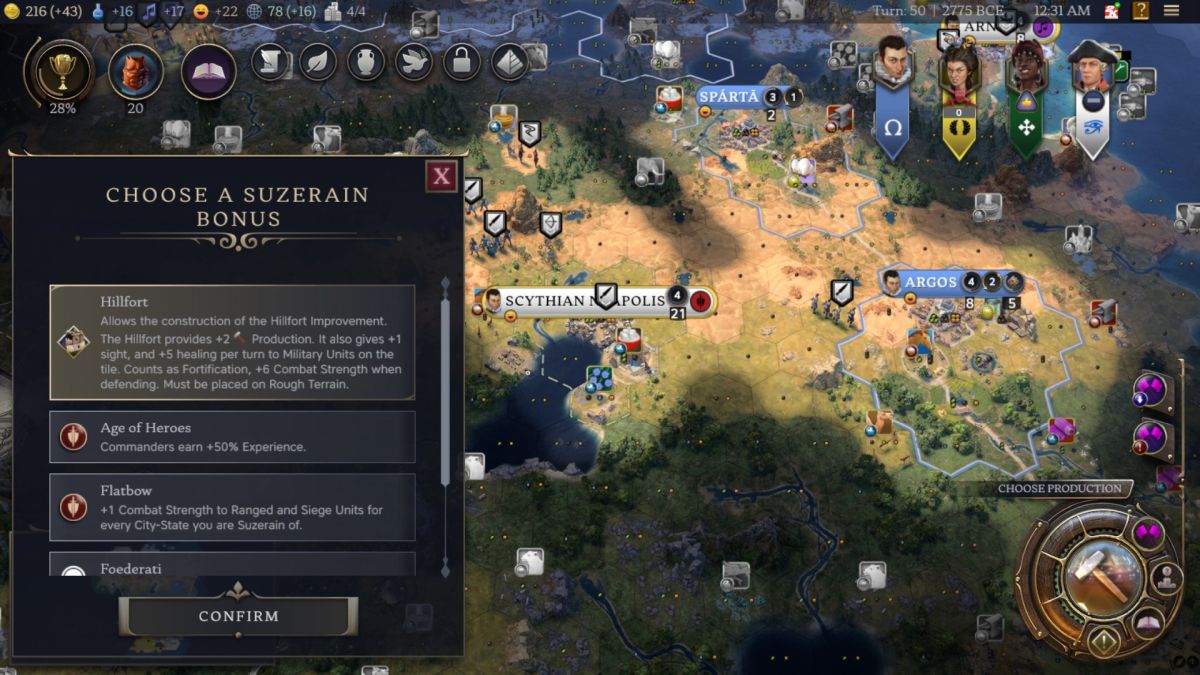
These things unlocked when my friendship with Scythian Neapolis finally matured on Turn 50. Hill forts added +2 production (along with the same 1 gold and 1 culture from my starting memento) onto the rough terrain where they were buildable. Since those "rough" tiles always used mines and quarries for their base rural improvement, this resulted in a bunch of tiles with 3 production yield which was sorely needed for this production-strapped variant. I would build up my Ancient era settlements with this megalith / hill fort combo everywhere as they were simply the most useful of the unique tile improvements associated with city states. The Commercial tile improvement was the emporium which adds 2 gold and another 2 gold if constructed at a city with a resource assigned. This wasn't as useful as getting more food and culture from the megalith. The Scientific option for this era was the step pyramid which provides 2 beakers and +1 happiness per adjacent river tile, however it could only be constructed on tiles with a natural happiness yield which wasn't too many of them. I skipped these because there was a better science tile improvement available in the Exploration age down the road which I planned to focus on in the next era.
It was really the megalith that I wanted, largely because food was so important for this variant. In a normal game, the player keeps getting city sizes "for free" as urban districts are constructed, and of course those buildings all have their own yields associated with them. For this variant though, the only way to grow in size or gain additional yields was to fill up the food box and that required lots of food. Thankfully this game was played after the Patch 1.2 changes that resulted in more logical city growth math, with additional city sizes requiring hundreds and not thousands and thousands more food, but this was still a real challenge. Megaliths helped supply the additional food that wasn't coming from granaries and baths to keep my settlements pushing along to greater and greater sizes.
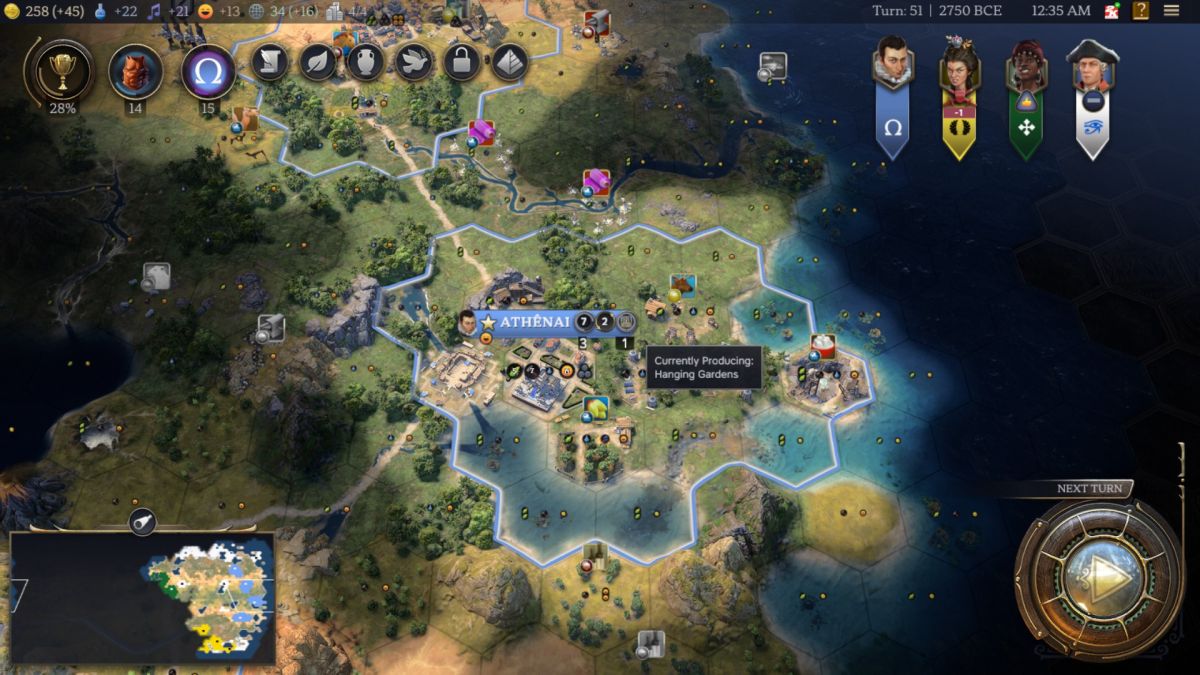
To that effect, I took the time to construct the Hanging Gardens in my capital for its +10% growth in all settlements effect. This was a very nice boost which would provide that small bit of extra help in growing to higher populations. The timing also worked out nicely as I had been stuck in a part of the tech and civic trees without any increases to the settlement cap and I wouldn't have been able to train more settlers anyway; that meant that if I wasn't planning on attacking someone, I might as well construct a key wonder. I used Shift-Enter production abuse to build the Hanging Gardens, something that I don't feel guilty about because Civ7 gives the player precisely nothing if they are narrowly beaten to a wonder. That feels incredibly harsh and it's crazy to me that there's no version of "failgold" or some other kind of pity reward when a player gets close to a wonder and misses it. So I simply built the wonder on an empty production queue and was ready to swap to a different build if the Hanging Gardens had been snagged away by someone else.
The Hanging Gardens also grants an Expansionist attribute point which I had no choice other than assigning to the entry in that tree: 25% faster construction of settlers. During these turns, I had two different pop-up messages appear that granted me the chance to take a Diplomatic attribute point. I was quite happy to get both of them which unlocked this option:
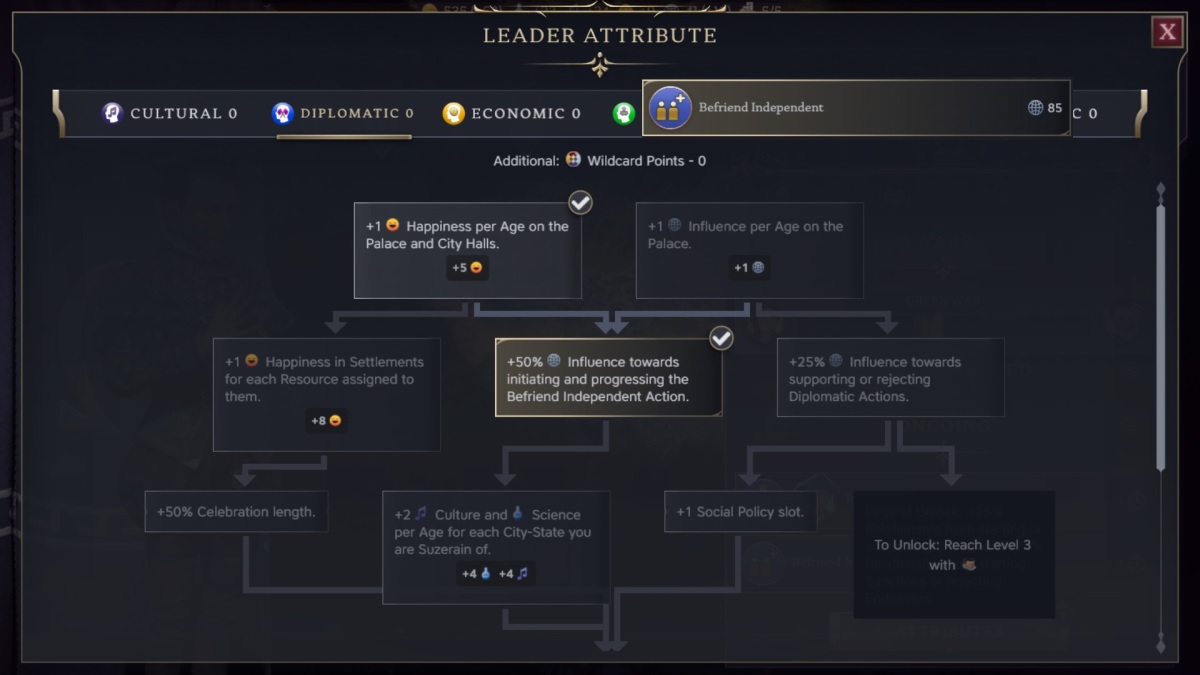
I took the single happy face on every settlement for my opener, then another +50% influence towards making friendships with independent powers. This duplicated the Greek Xenia policy for a total bonus of +100%, which worked out in practice to cutting half off the cost of each friendship with the IPs. When I found another Scientific IP in the far southwest corner of the map a little bit later, it only cost 85 influence to start allying with them which was barely 5 turns worth of influence. Again, the plan was to buddy up with every independent power on the map for their various bonuses, then do the same thing in the following eras where I would be able to carry over these same policies.
But wait a minute, you might be wondering, where did you get these Diplomatic attribute points from? I had noticed these things appearing in seemingly random fashion in my previous games without having any clue what was going on with the various narrative events. Fortunately someone at CivFanatics sorted this out and published a short guide to obtaining attribute points which I'll link here. It turns out that these attribute points aren't random at all, but rather each leader and each civ has a unique trigger associated with them that differs with each era. For Machiavelli, this requires researching the Discipline civic while for Greece it was form an alliance and/or become suzerain of a city state. (Technically that was the "Diplomatic" trait of Greece; I also could have and later did gain a Cultural attribute point from researching 6 civics.)
Anyway, the gameplay therefore has three different attribute points available to be collected in each era, two of them tied to the player's civ choice and one of them tied to their leader choice. This is a really neat idea and you'd think that it would be highlighted for the player so that they could plan around it and try to land the various objectives. Guess again, buddy: this entire mechanic is NEVER DOCUMENTED OR EXPLAINED anywhere in the gameplay.  The attribute points simply pop up out of nowhere with no explanation for what's happening - great idea for a strategy game, huh? What's even more maddening is the fact that Civ7 already has a quest log present! It's used to track quests that give the player XP associated with unlocking future mementos between games, but not used for these attribute point quests which are extremely relevant to playing the current game. I continue to be flabbergasted at how poorly put together everything is in Civ7; this is another fun and interesting mechanic that gets utterly wasted by a useless interface.
The attribute points simply pop up out of nowhere with no explanation for what's happening - great idea for a strategy game, huh? What's even more maddening is the fact that Civ7 already has a quest log present! It's used to track quests that give the player XP associated with unlocking future mementos between games, but not used for these attribute point quests which are extremely relevant to playing the current game. I continue to be flabbergasted at how poorly put together everything is in Civ7; this is another fun and interesting mechanic that gets utterly wasted by a useless interface.
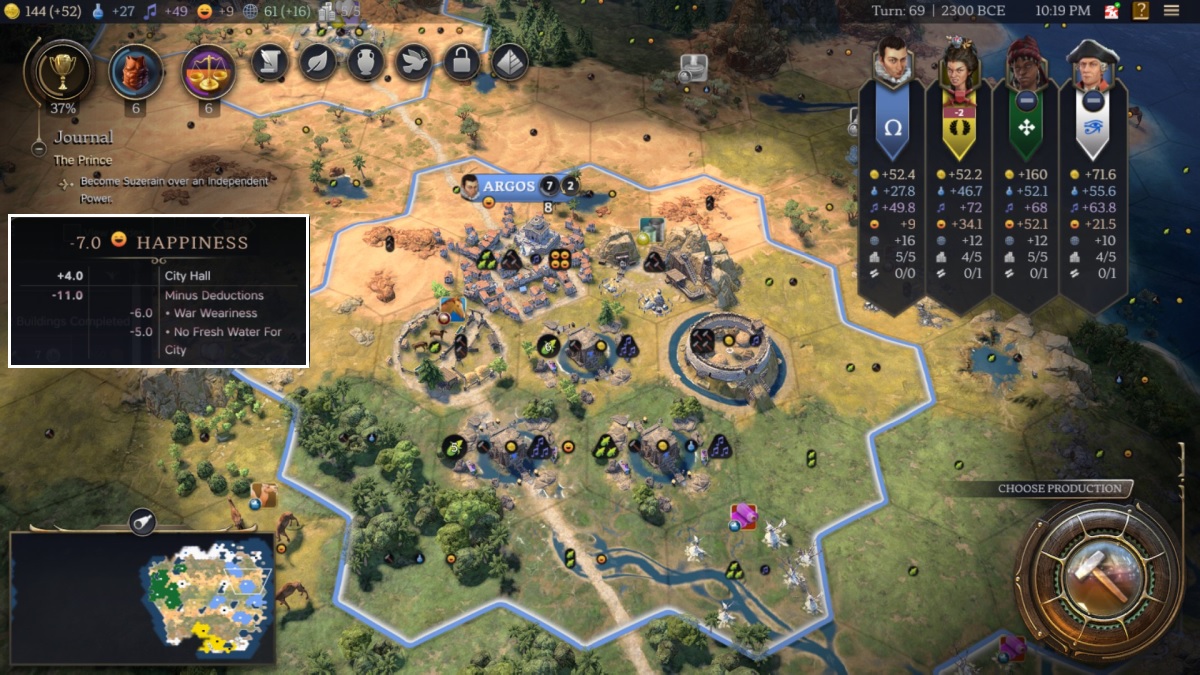
By Turn 70, I had pushed further west with a fifth settlement that was nestled in between a pair of allied city states. Protect me, independent powers! I still had no military of any consequence and was relying on their units for assistance. Here at Argos, I was starting to assemble a nice collection of the unique tile improvements thanks to a trio of megaliths and a hill fort. The next planned tile was directly to the south on the river where I'd boost two existing megaliths and could add a fourth version of the tile improvement. Argos was currently saving up production on an empty build queue for another run at a possible wonder, which could turn into an army commander if I was left holding an empty bag there. I was also able to capture the empire-wide comparative yields where I was continuing to do surprisingly well as compared with the AI leaders. While I didn't lead in any categories, I wasn't too far behind either, not bad for the Deity + no buildings combo.
The one area where I was struggling the most was happiness. I couldn't afford to plant any more settlements at the moment without driving too deeply into the negative values, where each unhappy face results in -2% to all yields in the associated settlement. The default Civ7 interface is almost completely useless at detecting what's driving unhappiness, however I had downloaded yet another interface mod that actually does show what's going on. I pasted in this image of the unhappiness at Mykene which had fallen to -7 happiness at the moment, driven almost entirely by war weariness with Catherine. We had been at war for more than two dozen turns at this point without me seeing anything beyond that first warrior. And yet, Cathy absolutely refused to sign a peace treaty either, argh! Go away and leave me alone you stupid girl!
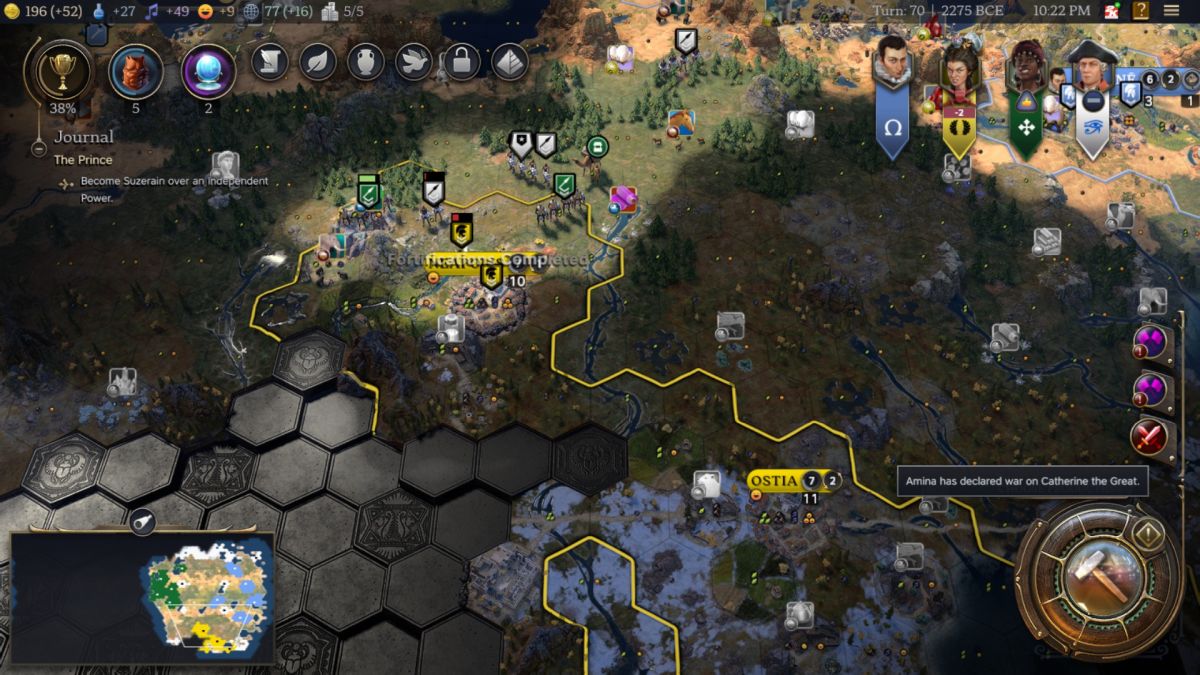
Thankfully Amina rode to my rescue with her own war declaration against Catherine on the following turn. This conflict resulted in no cities changing hands but Cathy was apparently worried enough that she did finally sign a white peace several turns later. Finally! Now I could escape from that annoying unhappiness penalty and look to start expanding once more. War weariness seems to increase gradually over time no matter what happens in Civ7, even though it made no sense for my people to experience "war weariness" from an invasion that saw zero fighting after defeating the initial attacker. I had been about to levy some units from one of the city states near Catherine and try to reprise my invasion from the previous Himiko game, fortunately that turned out not to be necessary.
This Ancient era went on long enough that I'm going to split it into two parts. My early gameplan of city state alliances was starting to bear fruit and would take full effect during the upcoming turns - stay tuned.



